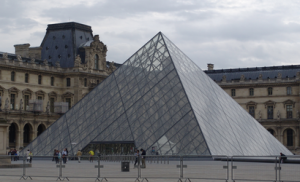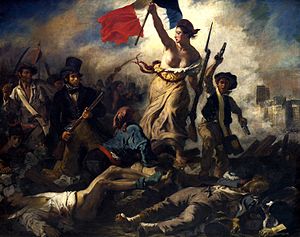Paris
I’ve been in love with art history since 10th grade when I got to dump my Latin textbook for Janson’s “History of Art.” Mrs Driscoll would take us to see Gauguin’s “Where Do We Come From?…” (1898) at Boston’s Museum of Fine Arts, instructing us how to read the lines, colors and shapes of a painting.
Fifteen years ago I paid for son Elliott’s high school trip to Europe and still treasure the Louvre catalogue he brought me. Back then I was finishing college and raising children, so travel much beyond the Pacific Northwest was not contemplated. Now that my last child is a senior at NYU, it seemed time I visited those French works in Janson. Husband Dave and I left Berlin on an easyJet for Paris—warning, hungover passengers and no pre-assigned seats on budget european airlines.
We checked into the Hotel Eiffel Capitol near the Dupleix metro station, compact rooms with fresh croissants for breakfast. The neighborhood had Italian (Pasta Papa) and Lebanese (Restaurant Feyrouz) and a corner bar so crowded that protecting our dinner plates from crashing on soccer nights was a challenge.
We walked the few blocks to the Eiffel Tower, and found it painted brown, not the jet black that Audrey Hepburn saw out her window in “Sabrina.” American school children were ascending the Tower like ants while their tired chaperones fanned themselves on benches below. The carnival-esque rides beneath those iron rods didn’t quite translate to romantic Paris, so we headed for Notre Dame on the Seine, this time imagining Cary Grant pursuing Hepburn on a riverboat from “Charade.”
A few blocks away, we climbed one of the two narrow circular stairwells to the nave of Louis IX’s Sainte-Chapelle and his magnificent thirteenth century stained glass windows. Sometimes great experiences don’t come from guidebooks. Paris restrooms don’t seem to refill their toilet paper. As a painter, I always pack a roll of paper towels. A Japanese woman without provocation handed me a Kleenex pack before I entered the Sainte Chapelle toilets, proving world peace could be solved by such gestures! We ate to die for onion soup at Café Panis across from Notre Dame and noted that French food seemed to use less sugar and salt than American faire. Drinking mineral water became routine although we did miss American Coke with its corn sugar and abundant ice.
It was time to tackle the trifecta of museums, the Louvre, the D’Orsay and the Pompidou where rooms are devoted to the likes of Ingres, Degas, and Kandinsky.
The Musee du Louvre is overflowing with history before getting into the art. It began as a 12th century fortress, recently excavated as “Medieval Louvre.” We constantly found ourselves lost and back in this Middle Ages pile of rubble, admittedly the dried-up moat and stacked brick walls are far better than any amusement park reproduction. From Charles V in the 14th century to Napoleon III in the 19th century, monarchs have taken up residence, remodeled and stored their acquired loot. The museum was opened to the public in 1793 which revolutionized the art world. Thereafter, salons questioned who should decide what kind of art was fit for the viewing public, a debate that continues today.
Completed in 1989, I.M. Pei’s large glass pyramid is surrounded by the three wings of the Louvre, contrasting the starkness of glass with the rougher stone façades. Below the pyramid’s apex is where the wings converge. The Louvre is a supermarket of art with eateries, expensive shopping and a metro stop. Mona Lisa is hard to see encased in so many layers of glass. Experiencing her is more about watching tourists push and take photos. We purchased special tickets for DaVinci’s “The Virgin and Child with St Anne” (1510), a much better triangular Renaissance composition in a quieter gallery.

The Musee d’Orsay is a converted eighteenth century Beaux-Arts railroad station maintaining the largest Impressionist collection in the world. Even after pre-purchasing passes we stood in line for an hour. The main area, where trains arrived and hearts were broken, is now a sculpture garden lined with benches. Noise and soot that once poured from steam engines have been replaced by intimate gallery stalls that allow light to radiate from the station cathedral-esque ceiling. Masterpieces like Manet’s “Le Dejeuner sur l’Herbe” (1863), shocked Parisian audiences who witnessed frocked coated gentlemen picnicking alongside a nude. Another shocker was Manet’s “Olympia” (1863), featuring a courtesan not only looking out at the viewer but also at her next john, imagined, not painted. This kind of three way observance is often used by modern filmmakers. The d’Orsay has an attic restaurant, Café Campana, where orange woven plastic divides and chairs resembling flower petals soften the severity of the railroad’s ochre walls, giving the tables privacy for sandwich or éclair munching under one of the giant wall clocks.
Designed by Renzo Piano, the Musee National d’Art Moderne is the largest modern art museum in Europe. (Note: If you lay over in Chicago you can see Piano’s more recent and restrained addition to the Art Institute.) Affectionately named the Pompidou after a French president, this museum resembles a roller coaster as much of the mechanicals are exposed and color coded. A system of covered escalators resembling a water park takes visitors to each floor as more rooftops of Paris are revealed while ascending. Hard to believe that German troops once goose stepped through boulevards below. And on a whimsical note, I imagined Peter Sellers buffooning his way around Paris trying to solve crimes with police sirens as the movie’s score.
The painter Georges Rouault’s work with his crude black brushstrokes and dark tones has never been a favorite. I always breeze by his art when it’s shown with other Impressionists. However, at the Pompidou I was drawn to his harlequin paintings and found them as provocative as clowns by Cindy Sherman or Walt Kuhn. The Pompidou is full of contrasting themes and textures. The museum’s exterior resembles Coney Island’s roller coaster. And the seemingly Spartan courtyard was full of tourists and workers chatting over lunch. There is a pricey restaurant at the top and shallow blackened pools with a soupçon of sculpture add sophistication to every level. Apparently, guards don’t mind children running down hallways kicking each other under priceless pieces. The ground floor resembles a bus station full of tourists lining up to buy tickets, browsing in souvenir shops or eating at the balconied sandwich café that feels like a fifties malt shoppe.
Our last day we took the pedestrian underpass to the Arc du Triomphe followed by a walk down the Champs Elysees where a large McDonalds and Peugeot dealership dominate this historic tree-lined boulevard – scene of Paris’ liberation in 1944. We subway’d to Montmarte hoping to find a nice café where we could envision Toulouse Lautrec sketching or Frank Sinatra pursuing night club owner Shirley McClain in Cole Porter’s “Can Can.”

Afterwards we walked to Eugene Delacroix’s home and studio with its big window and skylight. Delacroix’s back yard is hidden solitude inside a bustling city where visitors can read or sketch under trees. Delacriox’s atelier is possibly where he painted “Liberty Leading the People” (1830) a Romantic epic about restoring the Republic a la “Les Miz,” on view at the Louvre that owns Delacroix’s home.




